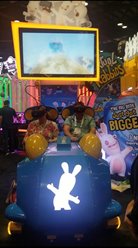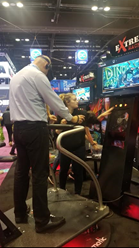In Star Trek: The Experience, you began your journey in the History of the Future, an exhibition of actual costumes and props used over the TV series’ history. Then you interacted with Star Trek characters onboard the U.S.S. Enterprise before you embarked on a mission through space and time via a simulated shuttle ride. After completing your mission, you enjoyed the Deep Space Nine retail promenade and had drinks at Quark’s Bar. This experience, which opened in 1998 and entertained Las Vegas Trekkies for ten years, was way ahead of its time.
Today, we’re seeing a resurgence of similar experiences and what we refer to as experiential entertainment—experiences that combine premium content and technology to immerse people in stories and worlds, both familiar and new, in real life.
Perhaps the best example of experiential entertainment and one indicator of its growth is Disney’s recent commitment to boost its theme parks business with an investment of nearly $25 billion over the next five years: It is spending more on this side of the business than it did to acquire Pixar, Marvel and Lucasfilm combined.
Of course, not all media companies have billions to spend or their own theme park divisions. Here are a few more indicators on a much smaller scale: The location-based entertainment market will grow to $12 billion in 2023 from $1 billion this year; the number of escape room companies has grown from 22 to 2,000 since 2014; immersive experience creator Meow Wolf earned $6 million in its first year open and still sees lines out the door; Refinery29 is doubling the number of locations for its profitable 29Rooms experience, with ticket prices near $40, up from $20 a year ago.
While there is nothing new about location-based or out-of-home entertainment, the opportunity today is that brands and media companies can create bigger experiences in smaller spaces, using new or existing IP and advanced technologies that enable connectivity, interactivity and personalization on location, and the extension of experiences off location (social media, live streaming, etc.). Brian Solomon, former creative director at Meow Wolf summarizes it well: “It’s akin to what digital video cameras enabled for a whole generation of filmmakers. That’s happening right now with IoT, game engines and accessible positional tracking equipment. There’s Disney Imagineering-level production happening on an indie level, and it’s only getting better.”
But why invest in building real-life experiences when digital gives you the scale of viewers, users and followers online? Experiential entertainment can extend the life and reach of your brand or IP beyond the screen. It’s like the old theme park and attractions model, except you don’t need thousands of acres and you have the opportunity to go direct to the consumer and be wherever the customers are. It becomes a new channel that can enhance the overall value of a brand or IP while:
- Generating awareness and attracting new customers who would have not known you otherwise
- Deepening engagement beyond the audiovisual, with multisensory stories that inspire broader and deeper ranges of emotions
- Creating a new customer touch point and enabling you to superserve your target audience in more than one area of their lives
But not all stories and spaces are created equal. In the past year, there have been dozens of new themed popups and “Instagrammable museums.” I visited about a dozen too many of these and found that most followed the same template: The experience takes you through a series of themed rooms (usually one infinity mirror room, a hallway of lights and other photo ops), then culminates with a pit of sprinkles, marshmallows or colored plastic balls that match whatever the theme is, followed by a small retail section. Tickets were $30 on average and lines were out the door, especially during the summer.



Grand finales at Candytopia, Color Factory and Nightmare Machine in New York.
While the popularity of these popups demonstrates the power of social media and desire for shareable experiences, many can be void of substance and meaningful experiences. Space is important, but it’s not the most important thing. And therein lies the opportunity for great storytellers, developers and IP—how can you translate the power of stories or gaming into physical spaces to convey an important message or to inspire emotional connections with and among visitors?
For Refinery29, 29Rooms certainly capitalizes on social media sharing, but it also continues to serve as an outlet for female creators to express their art, spark dialogue and inspire other women. At Two Bit Circus, Eric Gradman measures success in terms of “micro-friendships … strangers playing, eating and laughing side by side” and ensures success by infusing “the entire space with a backstory, characters and immersive theater.”
The blurring of lines between film, TV, gaming and physical exhibitions was a noticeable theme at this year’s International Association of Amusement Parks and Attractions (IAAPA) Expo. The presence of companies rooted in film/TV production, game development and augmented reality/virtual reality at the expo has grown in recent years. These companies are finding themselves in a new industry exploring ways to bring film, TV, and gaming content and technologies to location-based entertainment. On the flip side, traditional attractions and entertainment venues are experimenting with ways to incorporate the shareable, interactive and personalized aspects of online experiences into the real world.



Vendors on the floor of the IAAPA Expo in Orlando demo attractions for venues looking to incorporate the latest in interactive and storytelling experiences.
Finally, experiential entertainment can introduce new revenue streams. Up until now, much of what could fall under “experiential entertainment” has been experiential marketing activations. And there have been really great ones, especially at SXSW and Comic-Con. Beyond experiential marketing, what if you could create experiences that can be monetized directly and indirectly? Obviously, throughput and scalability are challenges of operating in the physical world, but with planning and design that are aligned with a different set of objectives, return on investment can come in many ways and forms. Guiding our clients through the various revenue opportunities and potential for return is an exciting part of our job.
For example, when you extend your IP into a real-life experience, you not only create a direct-to-consumer touch point but you also expand your audience platform for potential brand marketing partners. Improved data tracking and social sharing capabilities, such as those employed by Double A and MediaMonk, are attracting more budgets to experiential programs. One-third of chief marketing officers plan to spend up to 50% of their budgets over the next three to five years on experiential. With all the clutter in the digital world of content, experiential entertainment offers one of today’s most premium real estates for engaging with consumers.
Physical spaces have a lot of limitations, but with enabling technologies being used by the best creative minds, experiential entertainment can help media companies expand their IP and revenue streams, build new direct-to-consumer channels, and co-create memorable moments with their consumers.